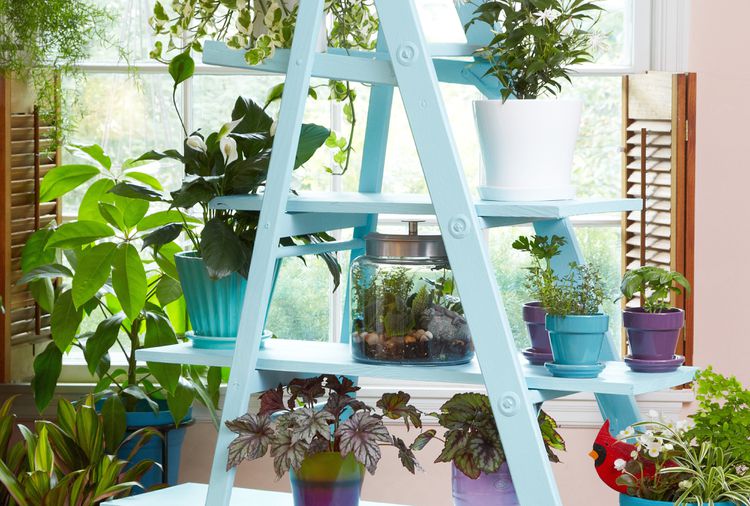How to fertilize indoor plants properly is an often misunderstood but essential maintenance task, whether you're growing tropicals or succulents or orchids in your home. All plants require nutrients to grow, and houseplants are no exception. Over time and with regular watering, nutrients are either washed from the potting soil or used up, leaving your plants without the vital elements they need to thrive. Here's when and how to fertilize indoor plants so you can keep everything green and growing.
Types of Fertilizers for Indoor Plants
There are two primary types of fertilizers to consider: synthetic and organic. It is often said that synthetic fertilizers feed the plant while organic fertilizers feed the soil.
Synthetic
Synthetic fertilizers are produced from ammonia, natural gas, and various mineral sources. These fertilizers are synthesized to exacting requirements and specific N-P-K ratios (that stands for nitrogen, phosphorus, and potassium) so that growers can target the exact needs of the plants. High-quality synthetic fertilizers usually contain trace amounts of micronutrients (the nutrients plants need in really tiny amounts) as well.
When using synthetic fertilizers, be careful that you don't end up over-fertilizing your plants (known as fertilizer burn), due to the high amounts of nutrients the synthetic fertilizers are formulated to provide. As with all fertilizers, always follow the mixing instructions on the product label.
Because synthetic fertilizers are produced using large amounts of chemicals and applied heavily on industrial farms, golf courses, and home gardens, they can (and do) create issues with runoff into waterways. Uncontrolled runoff can cause environmental harm, and care should be taken to avoid excess use.
Organic
Organic fertilizers are derived from natural ingredients that may or may not be organically sourced themselves. These fertilizers are commonly derived from agricultural or industrial byproducts, such as manure, bone meal, and blood meal, but others, including kelp and worm castings, are intentionally harvested.
Organic fertilizers are touted as a more sustainable option than synthetic types of fertilizer because they are easier on both the environment and the gardens or plants on which they are applied. Another benefit of organic fertilizers is that because of their biological sourcing, they are loaded with many macronutrients and micronutrients, better ensuring that when you feed your plants, they receive a broad range of the nutrients they need.
While organic fertilizers are excellent sources of nutrients, they tend to come in lower strengths than inorganic fertilizers; because of that, they are less likely to burn plants.
Pet owners should note that due to the slight fragrance from organic fertilizers, dogs and cats often find them irresistible, leading to uprooted plants and broken pots.
Acidifying Fertilizers
A sub-type of fertilizer that is worth mentioning is soil-acidifying fertilizers. These are usually—but not always—synthetic fertilizers that contain the same kinds of macronutrients and micronutrients found in other fertilizers. However, they also contain soil-acidifying ingredients to promote proper growth in plants that require acidic soils. Unless your plants specifically require acidic soils, it is best to avoid using these products.
When to Fertilize Indoor Plants
Knowing when to fertilize the plants is as important as choosing the type of fertilizer. Many plants grow in cycles in their natural environments. Under certain conditions, such as dry periods or cold weather, they slow their growth until conditions become favorable again. While conditions in the home do not typically fluctuate as much as they might outdoors, our homes and personal schedules act on indoor plants, creating less-than-ideal growing conditions.
When plants are under stress, or going through dormancy, they grow slower and require fewer nutrients. Fertilizing dormant plants can be detrimental to their health by inundating them with nutrients they are unable to use. This over-fertilizing can lead plants to become sickly or die—especially when they are young or already weak.
To play it safe, only fertilize plants when they are actively growing or flowering. Actively growing plants produce lots of new leaves, stems, flowers, and roots, which all need certain nutrients to develop properly.
Tips for Fertilizing Houseplants
Fertilizers come in many forms, including liquid, granular, and water-soluble, and each has a specific use. In addition to fertilizers meant to be absorbed by plants relatively quickly, many release nutrients into the potting soil over one to six months. These slow-release fertilizers are great long-term feeders, but they require moisture to work effectively.
Between feedings, it is important to water plants thoroughly to avoid a buildup of minerals in and around the roots. Ensure all the plant containers have holes in the bottom to allow excess water to drain out.
Regardless of the type of fertilizer you choose, follow the instructions listed on the label and dispose of any excess, outdated, or otherwise unused fertilizers properly.
Fertilizing plants is as much an art as it is a science and essential to good, healthy growth of potted plants. Once you get the hang of it, the process becomes second nature.




















